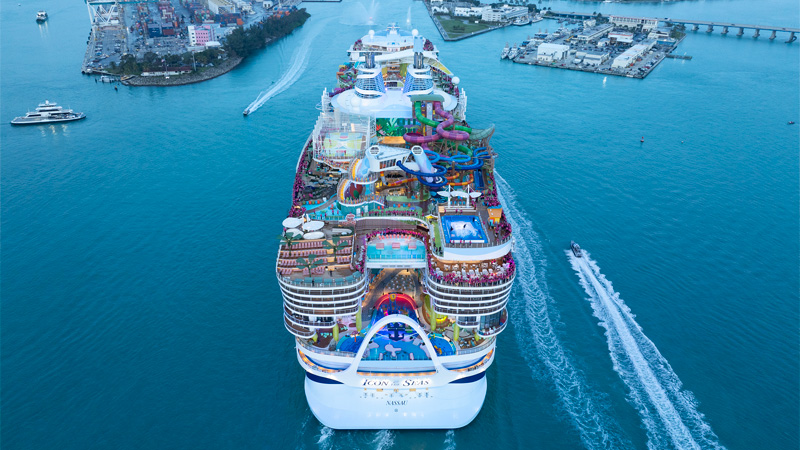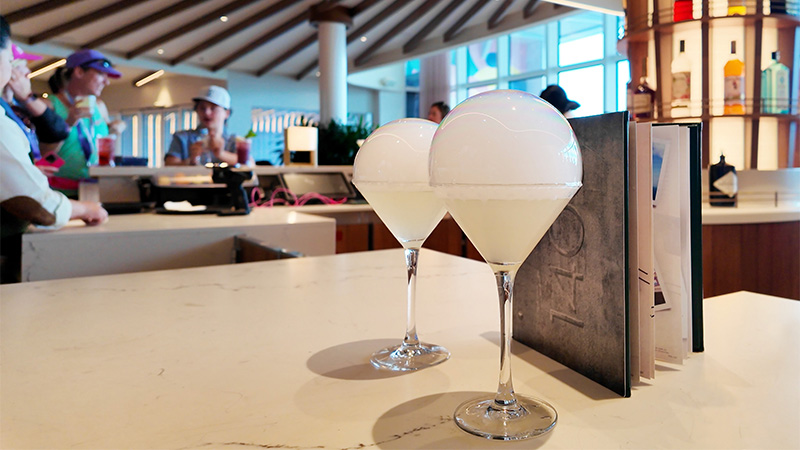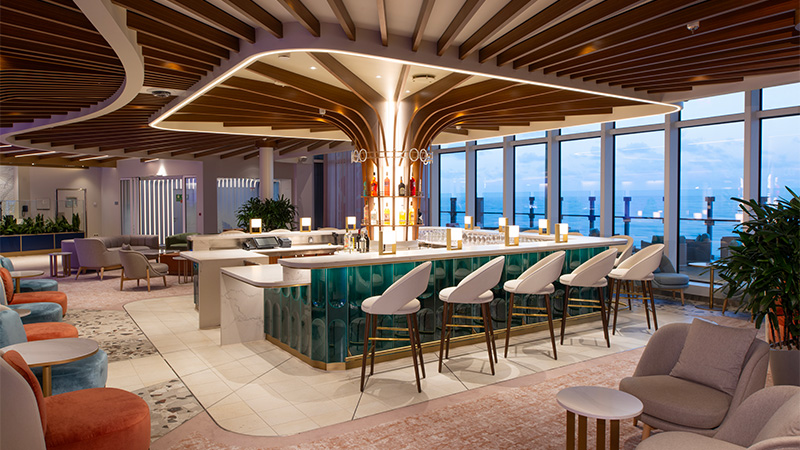Being a bartender on land is already no easy feat. So when you’re manning a bar (or several of them) on the high seas, it can be a sink-or-swim scenario: Supplies are limited, quarters are tight, and many guests can begin imbibing from the moment they wake up, especially if they signed up for an unlimited, all-inclusive drinks package. Those factors hold extra weight on the world’s newest and largest cruise ship, Royal Caribbean’s (RC) Icon of the Seas, whose inaugural sail took place in January 2024.

Fortunately, the ship’s team threw bar staff a life raft through solid prep work before the ship left the harbor. Award-winning mixology leaders Tony Abou-Ganim and Kim Haasarud collaborated with RC beverage director Ed Eiswirth and RC beverage and training manager Alexandra Palmeri to envision the look and taste of over 100 new drink recipes for guests to enjoy on the mega ship, with additional bells and whistles that include eight elaborately themed “neighborhoods,” six record-breaking waterslides, the world’s largest ice rink on a floating vessel, a 55-foot waterfall complete with olympic diver shows, and 40 restaurants, bars, and lounges — all to entertain 5,610 cruisers.
“It was a three-year process to refine the vision of each of the new bars and restaurants on board, not including the existing 25 on site that needed finessing,” says Eiswirth. “We wanted to make sure that every spot had its own unique personality and respective drinks to align with the ambiance and entertainment offered.” That includes Abou-Ganim’s self-proclaimed baby: 1400, the ship’s lobby bar on deck 6, which offers a mesmerizing signature cocktail that uses housemade shimmer pearl syrup (named after the $11 million dollar circular art structure on the same deck) complete with a citrus smoke bubble.
Don’t Miss A Drop
Get the latest in beer, wine, and cocktail culture sent straight to your inbox.
So after countless tweaks, tastings, and finalizing menus, what does it all mean for the crew who actually make all these drinks day-to-day? We asked lead bartender Monica Hernandez, who has been with RC for 13 years, to shed some light on the process and its challenges.
The Learning Curve
Before even setting foot on the ship, Hernandez says the entire bartending team headed to Spain for an intense, two-week cocktail bootcamp to prepare them for slinging drinks at sea.
“Each day was nine hours long, and it was basically like going back to school,” Hernandez adds. They were given walk-throughs of the new venues, the ones they would specifically manage on-site, and the technicalities of the drinks they would be creating. Hernandez oversees the Central Park neighborhood of the ship on deck 8, which includes Izumi Hibachi & Sushi (a Japanese fare and sake spot), Bubbles (a Champagne bar), Lou’s Jazz ’N Blues Bar (a New Orleans-inspired jazz club), Park Cafe (a grab-and-go deli), Trellis Bar (Amalfi Coast vibes), and Chops Grille (an American steakhouse). These new cocktail recipes her team had to learn would be in addition to the existing working knowledge of the usual suspects they’d make on the fly like Chocolate Mudslides, Strawberry Margaritas, Daiquiris, Mojitos, and those infamous Piña Coladas.
Limited Ingredients
On land, bartenders can be more spontaneous, more easily devise seasonal drinks menus, and tinker with ingredients as needed — but not on a moving ship. Instead of mile-long ingredient lists that are useful at typical bars, the ship’s drinks offer elevated flavors with no more than seven ingredients per cocktail. Additionally, to handle the sheer volume of orders, Hernandez says that certain specialty ingredients (such as the aforementioned shimmer syrup from 1400) are already made pre-service to ensure swift service and a consistent final product. That’s why Hernandez says it’s so important to adhere to the guidelines of making each drink as the recipe calls for, as well as to ensure quality control and consistency.

Hernandez adds that while she hasn’t experienced “drinks fatigue” from making the same cocktails repeatedly, she says that it would be interesting to see what other neighborhoods are like.
“It would be nice to trade places with a manager in one of the other zones, but for sanity’s sake, it’s probably for the best that we are organized this way,” she says. “We are so busy here already that I often lose track of the time, not realizing that the sun has already set.”
Little Down Time
“Getting to travel on a floating city and seeing the world is my dream job but definitely a gig that is not for everyone,” Hernandez says, citing long and erratic hours spent bouncing between graveyard and early-riser shifts and extended periods away from home and family. “I think the transition and learning curve for me and my team wasn’t as tough simply because I know what to expect now, but for newbies, it can be difficult.”
She adds that for new hires, the litmus test is their first sailing, which is a minimum of three months and up to eight months of consecutive sailing. “If you can survive your first contract, then you can likely brave whatever else upper management sends your way,” she says.
Controlled Chaos
“It’s all about creating key moments of relaxation and joy for them. If they sense you’re stressed, it will negatively impact their vacation.”
Hernandez says that, on average, her team makes 300 to 400 drinks daily in one venue alone. If the drink hasn’t been made well in 36 seconds to a minute, they’re already behind. While an unlimited drinks package is a dream for many vacationers, it can be a chaotic challenge for the crew when said guests don’t know their limit. “It comes with the territory … and I get it, your guard is down and you just want to relax,” Hernandez says. “In the case that a guest is unruly, loud, or disruptive, the best way to handle such situations is with grace.” She says in these moments it’s important not to embarrass and shame, but instead to exercise patience, empathy, and compassion.
Guests Relations
For better or worse, with the responsibilities of caring for over 5,000 guests on board, Hernandez says your work life becomes your personal life.

“To put it frankly, there isn’t a true break like you’re probably thinking of,” Hernandez explains. “We live under stress all the time. The lines between you and your working self are blurred, simply because once I’m done with a shift, it’s not as though I can leave my place of work.”
Ultimately, even if staff are feeling under the pressure, she says that it should never be felt by the guests on board. “They are our priority, especially when it comes to providing a hospitable experience and serving their beverages,” she says. “It’s all about creating key moments of relaxation and joy for them. If they sense you’re stressed, it will negatively impact their vacation.” She explains that if you don’t cultivate a high level of emotional intelligence to handle it all, the tension can trickle down into the drinks, or you can internalize a bar guest’s interaction with you and perceive it as negative.
Meeting Demand
Hernandez says that though it may be surprising, bartending and making the drinks is actually the easiest part of the gig. In fact, she says that her role frequently goes above and beyond making drinks. There are loyalty cruisers here who spend weeks on board and seek out Hernandez or her team for companionship, guidance, or simply a friendly face to connect with.
“This job requires you to also be a life coach, friend, psychologist, and everything else in between,” she says. “Where else can you build relationships, meet fascinating people from all over the world, and listen to the adventures they’ve had and want to share with you — all over a round of delicious cocktails?”